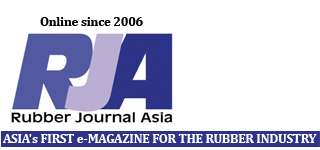Natural Rubber (NR) is an indispensable raw material for the global economy. Tyres account for the largest share of the world market and use a combination of NR and synthetic rubber (SR) to achieve the desired performance and durability. The ratio of NR to SR changes in different tyre types, where bigger sized tyres use more NR. Rubber-based components in cars use a higher level of SR in the blends. Many vibration isolation applications including bridge bearings, dock fenders and even earthquake bearings, use more NR. NR latex remains important in the manufacture of medical rubber products such as gloves and catheters.
According to Dr. Abdul Aziz S.A. Kadir, Secretary General, of Kuala Lumpur-based International Rubber Research Development Board (IRRDB), the world rubber industry has expressed concern over sustained global supply and availability. He goes on to say in a blog post, “Both NR and SR show signs of potential supply disruption. In the case of fossil fuel based SR, consumers continue to pressure the industry to change to renewables, as evidences blame fossil fuels for climate change. NR, though renewable, has to increasingly deal with problems of declining productivity, labour shortage, and low technology adoption by smallholders.”
He adds, “The fact remains that neither NR nor SR alone can satisfy all the performance requirements of rubber products. In high heat and oily environment applications, only certain types of SR can be used. Whereas, applications which have to withstand high heat build-up, as in aviation tyres, NR is irreplaceable.”
Supplying the world with the suitable rubber for the different applications is the biggest challenge, as the global rubber products industry shifts away from the non-renewables, according to Malaysia-based Kadir.
“The demand for investments in R&D to resolve such supply disrupting issues has grown more urgent. Both NR and SR need strategic R&D planning and directions. As the more renewable between the two, the use of NR should witness increasing demand. At the same time, R&D is urgently needed to produce renewables which can match the properties of SR. Modifying NR chemically or biologically, merits R&D considerations.”
As the world transitions into a NetZero economy, the option to make SR from renewable materials such as NR and other natural hydrocarbon sources should be explored.
Kadir continues, “In the case of NR, the R&D must focus on improving productivity, increasing yield and enhancing crop vigour. This is where the R&D in breeding must continue as a priority. Productivity improvement R&D would also include reducing immaturity period and yield losses through diseases and other causes. It may require undertaking missions to the Amazon regions to collect the remaining nine species of Hevea to widen germplasm base. These species have not been exploited commercially.”
Labour shortage is the other key element of productivity. “Less labour intensive technologies especially in harvesting must continue to be developed. This is where the R&D in digitalisation and automation become urgent. For the long term, R&D should also consider changing the model of NR production. The advancement in biotechnology must not be overlooked. In rubber product development, R&D should logically focus on meeting the growing consumer preference for green material.”
Kadir concludes, “The industry should not discount investing in the R&D to develop new ways to produce rubber latex through molecular techniques. However, the technologies generated through R&D are not of much use if they are not effectively translated into practice. The effective adoption of planting technologies transferred to farmers directly from researchers is more effective. The critical role of R&D and technology transfer in ensuring the world rubber economy is fed with a sustainable supply of rubber with the needed technical properties.”

